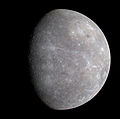Tập tin:Mercury in color - Prockter07 centered.jpg

Kích thước hình xem trước: 605×600 điểm ảnh. Độ phân giải khác: 242×240 điểm ảnh | 484×480 điểm ảnh | 775×768 điểm ảnh | 1.033×1.024 điểm ảnh | 1.991×1.974 điểm ảnh.
Tập tin gốc (1.991×1.974 điểm ảnh, kích thước tập tin: 1,72 MB, kiểu MIME: image/jpeg)
| Đây là một hình ảnh đã được chọn làm hình ảnh chọn lọc và được giới thiệu trên Trang Chính của Wikipedia tiếng Việt. |
Lịch sử tập tin
Nhấn vào ngày/giờ để xem nội dung tập tin tại thời điểm đó.
| Ngày/giờ | Hình xem trước | Kích cỡ | Thành viên | Miêu tả | |
|---|---|---|---|---|---|
| hiện tại | 12:49, ngày 4 tháng 6 năm 2008 |  | 1.991×1.974 (1,72 MB) | Papa Lima Whiskey | {{Information |Description=Full color image of from first MESSENGER flyby |Source=NASA/JPL [http://messenger.jhuapl.edu/gallery/sciencePhotos/image.php?page=1&gallery_id=2&image_id=143] |Date=2008-01-30 |Author=NASA/[[w:Applied Physics Laborato |
Trang sử dụng tập tin
Có 35 trang tại Wikipedia tiếng Việt có liên kết đến tập tin (không hiển thị trang ở các dự án khác):
- BepiColombo
- Caloris Montes
- Caloris Planitia
- Danh sách vật thể trong Hệ Mặt Trời theo kích cỡ
- Khí quyển Sao Thủy
- MESSENGER
- Mariner 10
- Pantheon Fossae
- Sao Thủy
- Sự đi qua của Sao Thủy
- Thăm dò Sao Thủy
- Tô Ngọc Vân (hố va chạm)
- Từ trường Sao Thủy
- Vulcan (hành tinh giả thuyết)
- Vulcanoid
- Vệ tinh giả thuyết của Sao Thủy
- Địa chất Sao Thủy
- Wikipedia:Bài viết chọn lọc/2013
- Wikipedia:Bài viết chọn lọc/2013/09
- Wikipedia:Bài viết chọn lọc/2013/10
- Wikipedia:Bài viết chọn lọc/2013/Tuần 39
- Wikipedia:Bài viết chọn lọc/2015
- Wikipedia:Bài viết chọn lọc/2015/06
- Wikipedia:Bài viết chọn lọc/2015/Tuần 23
- Wikipedia:Bài viết chọn lọc/2017
- Wikipedia:Bài viết chọn lọc/2017/12
- Wikipedia:Bài viết chọn lọc/2017/Tuần 51
- Wikipedia:Bạn có biết/2013
- Wikipedia:Bạn có biết/2013/Tuần 18/2
- Wikipedia:Danh sách hình ảnh chọn lọc của Commons/2008
- Wikipedia:Hình ảnh chọn lọc/2011/05
- Wikipedia:Hình ảnh chọn lọc/2011/05/26
- Wikipedia:Hình ảnh chọn lọc/Danh sách/Thiên văn
- Bản mẫu:Sao Thủy
- Cổng thông tin:Thiên nhiên/Bài viết/Lưu trữ
Sử dụng tập tin toàn cục
Những wiki sau đang sử dụng tập tin này:
- Trang sử dụng tại ab.wikipedia.org
- Trang sử dụng tại af.wikipedia.org
- Trang sử dụng tại ang.wikipedia.org
- Trang sử dụng tại anp.wikipedia.org
- Trang sử dụng tại an.wikipedia.org
- Trang sử dụng tại ar.wikipedia.org
- عطارد
- كوكب
- ويكيبيديا:هل تعلم
- بوابة:المجموعة الشمسية
- مارينر 10
- بيبيكولومبو
- قالب:عطارد
- عبور عطارد
- قالب:المجموعة الشمسية
- قائمة أجرام المجموعة الشمسية مرتبة حسب الحجم
- قائمة أجرام النظام الشمسي المستديرة بالجاذبية
- ويكيبيديا:هل تعلم/قائمة/68
- حوض كالوريس
- برنامج مارينر
- اكتشاف واستكشاف النظام الشمسي
- قائمة أنواع الكواكب
- مستخدم:محمد 19951/ملعب13
- عبور عطارد من الزهرة
- عبور الشمس
- بوابة:المجموعة الشمسية/قوالب
- جيولوجيا عطارد
- استكشاف عطارد
- مستخدم:ASammour/صور مختارة
- ويكيبيديا:هل تعلم/قائمة شاملة
- حقل عطارد المغناطيسي
- 1981 ميداس
- حفرة فلايانو
- قالب:بذرة كوكب عطارد
- غلاف عطارد الجوي
- عطارد في الخيال
- Trang sử dụng tại ar.wiktionary.org
- Trang sử dụng tại arz.wikipedia.org
- Trang sử dụng tại ast.wikipedia.org
- Trang sử dụng tại as.wikipedia.org
- Trang sử dụng tại avk.wikipedia.org
- Trang sử dụng tại awa.wikipedia.org
- Trang sử dụng tại bat-smg.wikipedia.org
- Trang sử dụng tại ba.wikipedia.org
Xem thêm các trang toàn cục sử dụng tập tin này.





